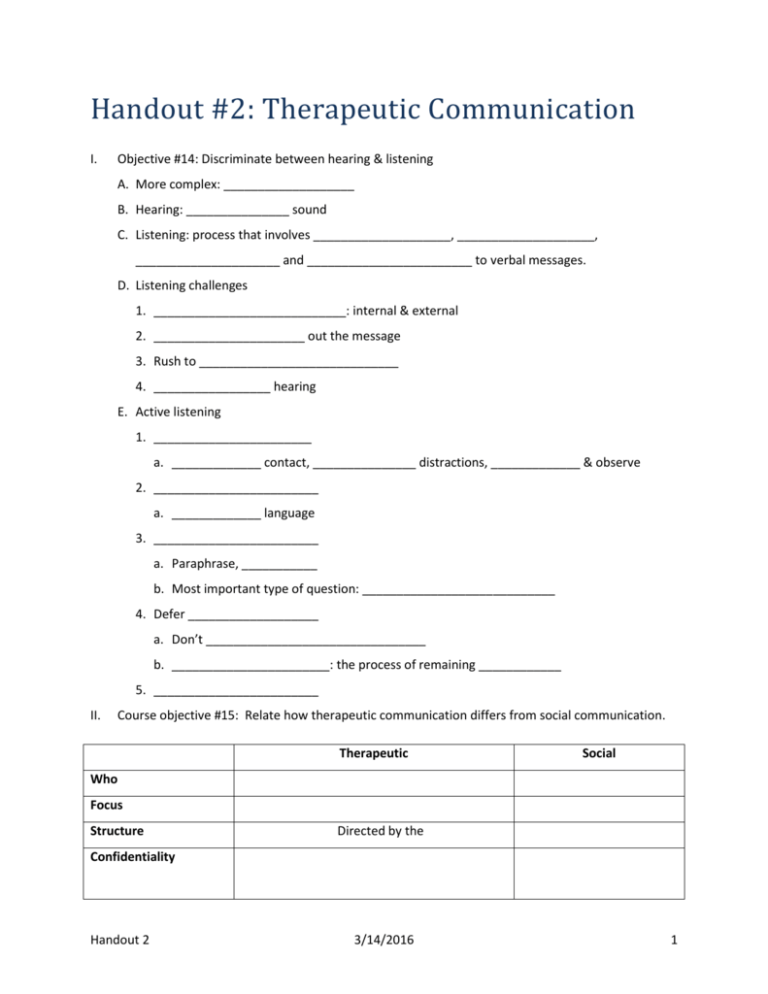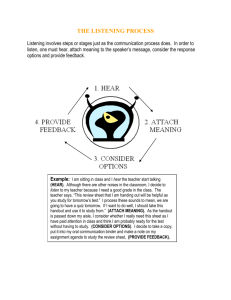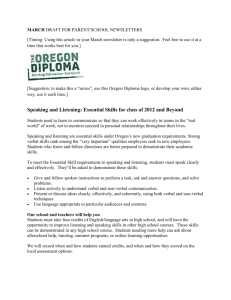Handout 2
advertisement

Handout #2: Therapeutic Communication I. Objective #14: Discriminate between hearing & listening A. More complex: ___________________ B. Hearing: _______________ sound C. Listening: process that involves ____________________, ____________________, _____________________ and ________________________ to verbal messages. D. Listening challenges 1. ____________________________: internal & external 2. ______________________ out the message 3. Rush to _____________________________ 4. _________________ hearing E. Active listening 1. _______________________ a. _____________ contact, _______________ distractions, _____________ & observe 2. ________________________ a. _____________ language 3. ________________________ a. Paraphrase, ___________ b. Most important type of question: ____________________________ 4. Defer ___________________ a. Don’t ________________________________ b. _______________________: the process of remaining ____________ 5. ________________________ II. Course objective #15: Relate how therapeutic communication differs from social communication. Therapeutic Social Who Focus Structure Directed by the Confidentiality Handout 2 3/14/2016 1 Client Professional Information III. Course objective #16: Define & describe the important of each of the following: readiness skills, attending skills, active listening skills, reflecting skills A. Readiness 1. Establish therapeutic _____________________________ 2. Choose a __________________ __________________ setting B. Attending 1. 90% _______________ 2. “You are _________________________ it me” 3. 4 Basic components a. __________________ 1) DO: Make _______ contact ; Be _______________ aware; __________ at the pt. frequently 2) DO NOT: _________________________________________ b. __________________ 1) DO: __________________ 2) DO NOT: _____________________, ________________________ 3) ___________________ the distance between 2+ people i. Intimate: ________________ ii. Personal: ________________ iii. Social:___________________ iv. Public: __________________ c. __________________ d. __________________ (encouraging) 1) Verbal: _______________________________________________ 2) Non-verbal: ___________________________________________ C. Active listening 1. Verbal _______________________ (Echoing) Handout 2 3/14/2016 2 a. Finding a ____________or two, towards the _________ of the senders _________________ that you can use to __________________ more clarification or discussion. b. “My girlfriend is great with my son. She has really been a life-saver to both of us.” 2. Echoing evaluation a. How accurately did you repeat your partner's words verbatim? b. How did you choose which words to repeat? c. What effect did verbal following have on the intensity and quality of your listening compared to silent listening or using minimal encouragers? d. What effect did verbal following have on how your partner disclosed information to you? e. At what point did you exceed your comfort level with verbal following? f. When might verbal following be a useful strategy with a client? g. What did you find easy about this activity? h. What did you find challenging? i. What do you need to work on improving with respect to verbal following? D. Reflecting / _________________________ 1. ____________________ before you speak! 2. Reflecting (_______________________) statements a. _______________________ communication b. Purpose 1) Convey __________________, Build ______________________ 2) Helps pt. ______________________ information & express _____________________ c. Rules 1) Only _______________ client; don’t _______________ 2) Listen for the _______________________ 3) Reflect the _________________ & __________________ d. Practice 1) Depressed Patient: “I feel like just sleeping or doing nothing but I can’t sleep at night though. It’s ridiculous. Maybe it’s because I worry too much” 2) Child: “I went to my grandma’s and she wasn’t home”. 3) Patient: “ I hate being in this hospital” 4) Patient: ”I don’t want any students looking in my chart” Handout 2 3/14/2016 3 e. Activity adventurous afraid alert amazed ambivalent angry annoyed astonished belligerent bold burned out calm capable cautious challenged comfortable concerned confident confined conflicted confused delighted depressed desperate disappointed disgusted easygoing ecstatic edgy embarrassed exasperated excited exhausted failure fantastic foolish frenzied frustrated funny gloomy guilty happy hopeful hopeless hurt ignored impatient inadequate indifferent inspired intimidated intrigued irate irritated jealous joyful lonely lost mad melancholy mellow misunderstood nervous nostalgic numb optimistic overwhelmed patient peaceful perplexed pessimistic positive pressured proud relieved resentful resourceful restless sad scattered skeptical startled stupid sure surprised tense tired uncertain uncomfortable unsure vigilant weary wistful wonderful worried f. Activity Evaluation 1) How accurately did you identify the feelings communicated by your partner? 2) If a mismatch occurred between the feeling you perceived and the one your partner conveyed, what might account for the mismatch? 3) Which cues from your partner did you tend to use the most in helping you identify the feelings? 4) Which cues did you tend to use the least? 5) What did you find easy & what did you find challenging about this activity? 6) What do you need to work on improving with respect to perceiving and reflecting feelings? 3. ______________________________ (Reflecting of __________) a. Use your __________ words b. Help ____________________ inconsistencies 4. ______________________ checking a. Prevents ____________________________ & ____________________ b. Goal ____________________ understanding Handout 2 3/14/2016 4 c. Procedure 1) _____________________: __________________________________ 2) Interpretation: Provide _______________________________________ 3) Request _________________________________ IV. Course objective #17 Explain the concept of therapeutic self A. Use of self - _____ therapeutic ____________________ B. 3 Interventions of psychotherapeutic management 1. Therapeutic ______________________________ 2. Psycho __________________________________ 3. ___________________ management C. Objectivity: Undistorted by ___________________ or personal _______________ D. Empathy: “Ability to _______________________ & _________________ the patients ______________ and point of view _________________________” EMPATHY Accurately SYMPATHY Shares Shared Taking on other Emotionally V. Emotionally Describe and give examples of each of the following communication techniques and where they are commonly used in the nursing process. A. Giving information: Making available ________________ the patient needs 1. Skill: ______________________________________ 2. Example: ______________________________________________________ B. Giving recognition: Acknowledging, indication _____________________ 1. Better than a ________________________________ 2. Skill: ____________________________________ 3. Example: ______________________________________________________ C. Showing acceptance: Giving indication of ______________________________ 1. Skill: __________________________________________ Handout 2 3/14/2016 5 2. Example: ______________________________________________________ D. Offering of self: Making one’s self ______________________________ 1. Types a. __________________ b. __________________ c. __________________ 2. Example: __________________________________________________________ E. Making observations: ____________________ what is __________________________ 1. Skill: ___________________________________ 2. Example: _____________________________________________________________ F. General leads: Encouragement to ________________________ 1. Rule: _____________________ 2. Example: _____________________________________________________________ G. Broad openings: Allows the patient to take the _________________ in ________________ a topic 1. __________________________ 2. Skill: __________________________________________ 3. Example: _________________________________________________________________ 4. _________-ended questions: ___________________ be answered with 1-2 words H. Encouraging descriptions of perceptions: Asking _____________ to ______________ what he perceives 1. Helpful with ___________________________ 2. Example:__________________________________________________________________ I. Clarification: Seeking information to __________________________ 1. Examples: _________________________________________________________________ a. ____________________________ b. Avoid _________________________________ c. Helps pt. become more _______________ of their ____________________ J. Reflecting: Directing back to the pt______________________, feelings & ideas 1. Helpful: ______________________________________ K. Restating: _______________________________ 1. Repeating the _________________________________ Handout 2 3/14/2016 6 2. Example: L. Exploring: ___________________ further into a _______________ or idea 1. Helpful: Patients who remain on a ____________________ level of communication 2. If a patient chooses not to delve ________________________________________ 3. Expanding __________________________________________________________ 4. Examples: ____________________________________________________________ M. Verbalizing the implied: ______________ what the patient has _____________ at or suggested 1. Rules a. Make less ________________________ b. Be ______________________________ c. Express only what is ________________________ 2. Helpful: __________________ or ____________________ verbal communication N. Encouraging comparison: Asking that ____________________ & _________________ be noted 1. Example O. Translating into feelings: ___________________ 1. Find _____________________ in the ____________________ meaning 2. Example: ____________________________________________________________________ P. Sequencing 1. Placing _________________in sequence of ________________ 2. __________________ 3. Gives ___________________________________ 4. Example: _____________________________________________ Q. Stating reality: Offering consideration that which is ___________________ 1. Patient ______________________________ 2. Nurse: Defines _________________________ or perception 3. Example: ________________________________________________________________ R. Voicing doubt: Expressing _____________________ as to the __________________ of the patients perceptions 1. Careful: _____________________________ 2. Benefit: __________________________________ 3. Examples: _________________________________________________________________ S. Focusing: Concentration on a ________________ point (________________ / ____________) Handout 2 3/14/2016 7 1. Helpful: __________________________________________________________________ 2. Example: _________________________________________________________________ T. Silence: ___________________ of verbal communication 1. Encourages: _______________________________________________________________ 2. ______________ pace 3. Give __________________ 4. Silence is Golden: Multiple __________________________ valuable _______________ 5. Activity evaluation a. Estimate how long you listened silently before you became uncomfortable. b. Once you found yourself becoming uncomfortable, what did you do? What went through your mind? c. What effect did your silence have on how your partner disclosed information to you? d. How did you know your partner was finished talking before you asked a question or made a comment? e. Estimate your tolerance level for keeping silent (high, pretty good, fair, poor, none) f. What factors do you think affect your tolerance level for listening silently? g. What can you do to improve your tolerance for silent listening? VI. Course Objective #19: Recognize and list non-therapeutic interventions A. Red flag words: 1. _____________ 2. _____________ 3. _____________ 4. _____________ 5. _____________ 6. _____________ 7. _____________ B. Belittling, _________________, mocking, ______________________ 1. Patient feels ___________________, _____________________ validity of their feelings 2. Examples: ______________________________________________________________ C. Giving ___________________ responses 1. Examples: ______________________________________________________________ D. Challenging: Demanding __________________________ Handout 2 3/14/2016 8 1. Examples: ______________________________________________________________ E. ___________________: Opposing the patients ideas 1. Examples: ______________________________________________________________ 2. Be non-___________________________ a. Word, ___________________ & _____________ language F. ____________________: statement that show you believe the person is correct 1. Examples: ______________________________________________________________ 2. Results: a. Shuts ________________ b. Places value _______________________ on behavior c. ___________________ assume responsibility G. _____________________/ Justification: Counter replay to a verbal ____________________ 1. Nurse = ________________________ 2. Patient = intimidated & _________________________________ 3. Examples: ______________________________________________________________ H. _______________________ responses: _____________________ 1. Superficial 2. Examples: ______________________________________________________________ I. Giving __________________ reassurance: Without ________________________ 1. AKA: ________________________ 2. Examples: ______________________________________________________________ J. Giving ________________________: Telling the patient ___________________________ 1. ____________________________ 2. ____________________________ 3. Patient ______________________ 4. Examples: ______________________________________________________________ K. ___________________ the subject: Introducing a ______________ topic 1. Examples: ______________________________________________________________ L. Asking _________________ - ending questions: Questions with ________ word answers M. Asking _________________ questions: Requesting an _______________________ 1. Put them on the ___________________________ N. ____________________: Seeking info beyond what is necessary Handout 2 3/14/2016 9 VII. Course objective #20: Recognize communication deficits in clients and teach appropriate social skills. A. Use ________________________ words B. _________ messages = _______________________ C. _________ messages = _______________________ 1. ____________________ - ______________________ - disrespect D. Guidelines for CONSTRUCTIVE feedback 1. _____________________ 2. _____________________ 3. Be ____________________ 4. Explain ____________________________ 5. Avoid ____________________________________ 6. Evaluate ________________________ , not the performer 7. Use _________________________ knowledge 8. ________________ on how to _______________it happening again E. Giving Praise 1. Be _________________________ 2. ____________________________ 3. ____________________________ 4. Area of ______________________________ 5. Be _________________________ F. “Touching” in therapeutic relationship 1. What are the advantages of touching 2. What are the disadvantages of touching 3. When and where is it appropriate? 4. When and where is it NOT appropriate? Handout 2 3/14/2016 10 Handout 2 3/14/2016 11




